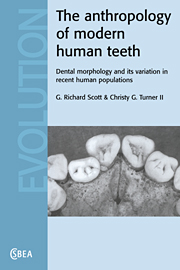 The Anthropology of Modern Human Teeth
The Anthropology of Modern Human Teeth Book contents
- Frontmatter
- Dedication
- Contents
- Acknowledgments
- Prologue
- 1 Dental anthropology and morphology
- 2 Description and classification of permanent crown and root traits
- 3 Biological considerations: ontogeny, asymmetry, sex dimorphism, and intertrait association
- 4 Genetics of morphological trait expression
- 5 Geographic variation in tooth crown and root morphology
- 6 Establishing method and theory for using tooth morphology in reconstructions of late Pleistocene and Holocene human population history
- 7 Tooth morphology and population history
- Epilogue
- Appendixes
- References
- Index
2 - Description and classification of permanent crown and root traits
Published online by Cambridge University Press: 05 September 2015
- Frontmatter
- Dedication
- Contents
- Acknowledgments
- Prologue
- 1 Dental anthropology and morphology
- 2 Description and classification of permanent crown and root traits
- 3 Biological considerations: ontogeny, asymmetry, sex dimorphism, and intertrait association
- 4 Genetics of morphological trait expression
- 5 Geographic variation in tooth crown and root morphology
- 6 Establishing method and theory for using tooth morphology in reconstructions of late Pleistocene and Holocene human population history
- 7 Tooth morphology and population history
- Epilogue
- Appendixes
- References
- Index
Summary
Terminology
Dental anatomy is a common ground shared by paleontologists, odontologists, dental anthropologists, geneticists, dentists, and other specialists whose work involves teeth. Paleontologists interested in long-term dental evolution have developed nomenclatures intended to impart phylogenetic information on homologies in crown structures. Dental anatomists and dentists, minimally concerned with homologies, use positional terms for major cusps and other features of the tooth crown that are unambiguous if somewhat cumbersome (e.g., mesiolingual cusp vs. protocone). With workers coming from many disciplinary backgrounds, papers on dental anthropology contain positional terms, paleontological terms, or a combination of both. For this reason, it is necessary to describe briefly each system of nomenclature.
Positional terms
In reference to the maxilla and mandible, the midline falls directly between the central incisors. As the human jaw is parabolic, with teeth arcing toward the midline in the canine region, the terms anterior and posterior are not always appropriate to describe the ‘front’ and ‘back’ of a tooth. Instead, mesial and distal are generally preferred to denote the part of a tooth closest to or farthest removed from the midline, respectively. When the terms anterior and posterior are used, it is in the context of anterior teeth, the incisors and canines, versus posterior teeth, the premolars and molars. For the ‘sides’ of teeth, that aspect of a tooth facing the tongue is lingual or medial. Terms for the outer surface of a tooth are more varied. For the incisors and canines, the surface in contact with the lips is labial, while the surface adjacent to the cheeks for premolars and molars is buccal. To avoid using two terms for the same surface, some authors use buccal for both anterior and posterior teeth or substitute the term facial. As with the labial-buccal dichotomy, the chewing surfaces of the crown are referred to as incisal for anterior teeth and occlusal for posterior teeth. Occlusal is favored if only one term is applied to all teeth. Approximal or interproximal are synonymous terms that refer to the mesial and distal contact surfaces between adjacent teeth.
- Type
- Chapter
- Information
- The Anthropology of Modern Human TeethDental Morphology and its Variation in Recent Human Populations, pp. 15 - 73Publisher: Cambridge University PressPrint publication year: 1997
- 6
- Cited by


